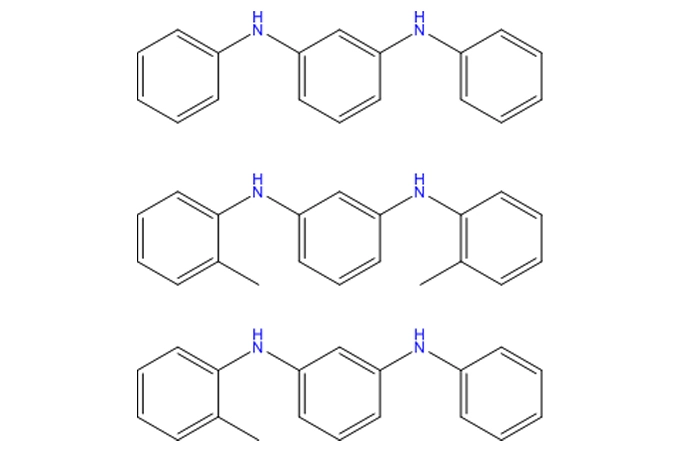Mixture of Diaryl-p-phenylenediamines (DTPD)
Antioxidant PA100 (similar to Wingstay 100 of Goodyear and ACCINOX 100 of ICI) is a mixture of diaryl-p-phenylenediamines, which can be classified in p-phenylene antioxidant, is excellent antiozonant to chloroprene rubber.
PA100 can be used as an antioxidant, antiozonant, and anti-flex cracking agent for many natural and synthetic elastomer compounds. Its capacity to resist groove cracking and flex cracking is similar to antioxidant 4010 NA or 4020, superior to antioxidant A and antioxidant D.
Additional benefits of PA100 are low volatility, low reactivity, resistance to water extraction, and a low migration rate. These characteristics allow PA100 antidegradants to provide long-term protection in tires and other rubber goods. It is the effective antioxidant used in the tire industry and also widely used for rubber products.
In addition to compounded products, PA100 can be used for polymer stabilization and will provide excellent.

| Synonyms | Wingstay 100, ACCINOX 100 |
CAS Number | 68953-84-4 |
EINECS Number | 273-227-8 |
Chemical Structure |
|
Packing | Antioxidant PA100 is supplied in 25Kg HDPE lined paper sack. |
Note | All information in the leaflet is based on our present knowledge and experience. We reserve the right to make any changes according to technological progress or further developments. Performance of the product described herein should be verified by testing. We specifically disclaim any other express or implied warranty of fitness for a particular purpose or merchantability. We disclaim liability for any incidental or consequential damages. Chemical Name of Antioxidant 4010NA (IPPD): N-isopropyl-N'-phenyl-p-phenylenediamine CAS No.: 101-72-4 Chemical Name of Antioxidant 4020 (6PPD): N-(1, 3-dimethylbutyl)-N'-phenyl-p-phenylenediamine CAS No.: 793-24-8 |
Diaryl-p-phenylenediamines (DTPD) is a type of antioxidant used in various industries, particularly in the rubber and plastic industries. Here are some of the benefits and applications of DTPD:
Rubber Industry: DTPD is widely used as an antioxidant in the production of rubber products. It helps to prevent the oxidative degradation of rubber, thereby extending its lifespan and improving its performance. This is particularly important for rubber products that are exposed to heat, light, and oxygen, such as tires, belts, hoses, and seals.
Plastic Industry: DTPD is also used as an antioxidant in the production of certain types of plastics. It helps to prevent the oxidative degradation of the plastic, thereby improving its stability and lifespan.
Lubricants: DTPD can be used in the formulation of lubricants to improve their oxidative stability. This can help to extend the lifespan of the lubricant and improve the performance of the machinery or equipment in which it is used.
Adhesives and Sealants: DTPD can be used in the formulation of adhesives and sealants to improve their oxidative stability. This can help to extend the lifespan of the adhesive or sealant and improve its performance.
Food Packaging: DTPD can be used in the production of food packaging materials to prevent the oxidative degradation of the packaging, thereby helping to maintain the quality and safety of the food.
Wire and Cable: DTPD can be used in the production of wire and cable insulation to improve its oxidative stability, thereby extending its lifespan and improving its performance.
In addition to these applications, DTPD can also be used in other industries and applications where oxidative stability is important. However, like all chemicals, it should be used with care and in accordance with safety regulations.
Color and Appearance | Brownish Granules |
Initial melting Point | 92°C |
Heating Loss (65°C) | 0.5% Max. |
Ash Content (800°C) | 0.3% Max. |
Active Components | 80.0% Min. |
Diphenylparaphenylenediamine | 16~24% (CAS No.: 74-31-7) |
Ditolylparaphenylenediamine | 15~23% (CAS No.: 27417-40-9) |
Phenyltolylparaphenylenediamine | 40~48% |
Diphenylamine Content | 6.0% Max. |
Iron Content | 750ppm Max |
Insoluble in water. Moderately soluble in toluene and carbon tetrachloride.